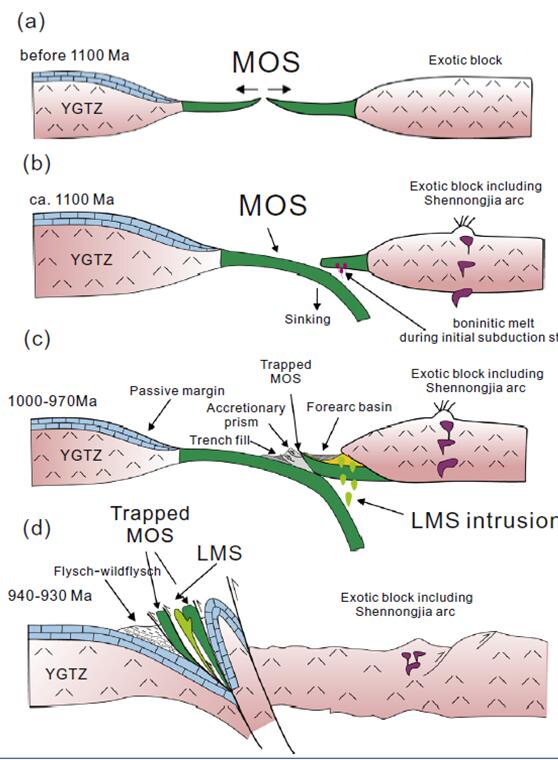Hao Deng, Songbai Peng, Ali Polat, Timothy Kusky, Xingfu Jiang, Qingsen Han, Lu Wang,Yang Huang, Junpeng Wang, Wen Zeng, Zhengxiang Hu. Neoproterozoic IAT intrusion into Mesoproterozoic MOR Miaowan Ophiolite, Yangtze Craton: Evidence for evolving tectonic settings. Precambrian Research, 2017, 289: 75–94. (SCI) http://dx.doi.org/10.1016/j.precamres.2016.12.003
Abstract
The Miaowan Complex in the Northern Yangtze Craton consists mainly of layered fine-grained metabasites, pillow lavas, sheeted dikes, gabbros, sepentinized harzburgite, and sepentinized dunite, with rare metasedimentary rocks in the metabasite section, and was initially regarded as an ophiolite complex. In this study, we divide the Miaowan Complex into two suites including the Miaowan Ophiolite Suite and a Late Magmatic Suite, based on differences in the degree of deformation, age and geochemical characteristics. The Miaowan Ophiolite Suite (MOS) mainly consists of ductily deformed serpentinized harzburgite, sepentinized dunite, gabbro, sheeted dikes, basalt, plagiogranite, and layered metasedimentary rocks. All these units were then intruded by the Late Magmatic Suite (LMS) consisting of pegmatiticisotropic gabbro and massive diabase. Magmatic zircons from a deformed gabbro in the MOS yield an age of ca. 1115 Ma, consistent with the whole-rock Sm-Nd errochron age (1135 ± 54 Ma) of harzburgite, gabbro and basalt in the MOS. Hence, the formation age of the MOS is interpreted to be ca. 1115 Ma. Harzburgites in the MOS are characterized by smooth LREE-depleted and flat MREE-HREE patterns; whereas dunites in the MOS display U-shape REE patterns. Deformed gabbro and basalt in the MOS display flat to slightly LREE enriched patterns, and low Th/Yb ratios and a lack of Nb anomalies, showing NMORB affinities. The initial eNd (t) values of rock units in the MOS range from +6.6 to +7.8, indicating that the MOS was derived from a strongly depleted mantle source. Accordingly, the harzburgite, gabbro and basalt in the MOS are interpreted to have formed in an oceanic spreading center and the dunites in the MOS were formed by reaction between the harzburgites and the subduction-related boninitic melts when the MOS was trapped with the harzburgites as a part of the mantle wedge above a subduction zone in response to the initiation of an intra-oceanic subduction system. Igneous zircons from late pegmatiticisotropic gabbros in the LMS yield weighted mean 207Pb/206Pb ages of 973 ± 15 Ma, 999 ± 17 Ma and 1002 ± 19 Ma, respectively, suggesting that the LMS was intruded between ca. 1000 Ma and ca. 970 Ma, consistent with their whole-rock Sm-Nd errochron age (1007 ± 62 Ma). Pegmatitic-isotropic gabbro and diabase in the LMS are characterized by enriched-LREE patterns with high Th/Yb ratios and negative Nb and Zr anomalies, consistent with a subduction-related setting. The initial eNd (t) values of rock units in the LMS range from +6.0 to +7.2. It is suggested that the LMS formed in a depleted fore-arc setting. Collectively, the Miaowan Complex consists of two magmatic suites including an older MORB-type ophiolitic suite and a younger arc-related magmatic suite, recording the evolution of geodynamic settings in a Proterozoic ocean.
Based on previous studies and this contribution, a new tectonic model is proposed for the Mesoproterozoic-Neoproterozoic geodynamic evolution of the northern margin of the Yangtze Craton: (1) the N-MORB-affinity mafic-ultramafic rocks in the MOS formed in an oceanic basin at ca. 1115 Ma; (2) subduction was initiated at ca. 1100 Ma beneath the MOS on which the ca. 1100 Ma Shennongjia arc (north of the MOS) was built; the MOS formed the overriding plate in this subduction zone with the harzburgite trapped as a part of the mantle wedge and reacting with the subduction-related boninitic melts forming dunite with U-shaped REE patterns; (3) with subsequent slab roll-back and opening of a fore-arc basin, forearc-affinity mafic rocks in the LMS were generated and intruded the ophiolitic maficultramafic rocks between ca. 1000 Ma and ca. 970 Ma; and (4) the northern Yangtze Craton is inferred to have collided with the Shennongjia arc and MOS + LMS at ca. 940–930 Ma.

A simplified geodynamic model for the Miaowan Complex, Northern Yangtze Craton. YGTZ = Yangtze Craton.

